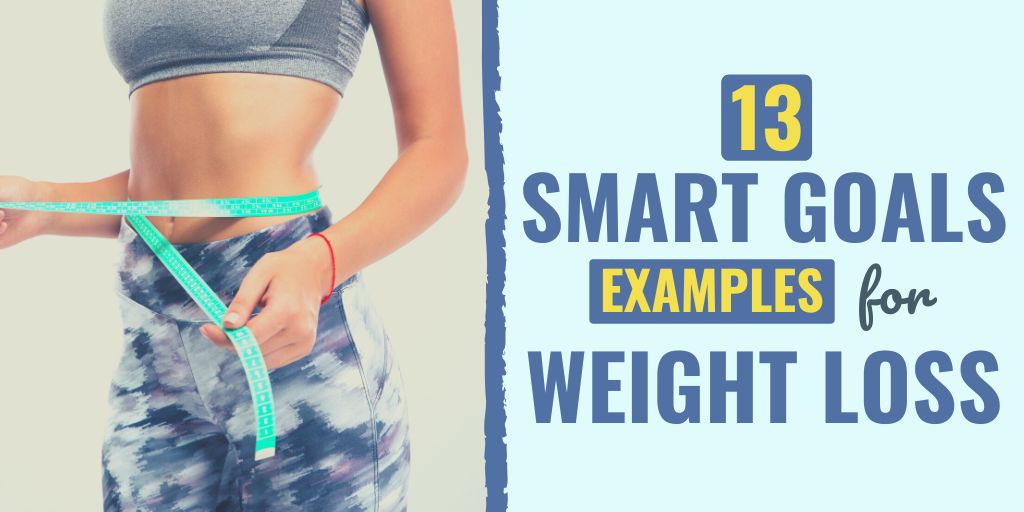There might be affiliate links on this page, which means we get a small commission of anything you buy. As an Amazon Associate we earn from qualifying purchases. Please do your own research before making any online purchase.
Improving health and fitness is something that is on the mind of many people. We want to be fitter to stay healthy so we can be there for our family and friends. We want to be more attractive and live longer.
And when thinking about physical health, body weight is often in the front of people’s minds.
Knowing that you’re in control of your body weight is an empowering thing, but it can feel very defeating if you make weight loss goals year after year that never get met.
The key to success with your weight loss goals is to make them into SMART goals, so the steps you have to take (literally and figuratively) are clearly laid out for you in a fail-proof way.
In this article, we are going to look at the value of SMART goals and why you should know how to use this goal-setting tool to lay the foundation for your weight-loss success. Then we will go over SMART goal statements that, if followed closely, will guarantee you see the results you’re envisioning.
But let’s start by looking at what a SMART goal is and why it’s so effective.
What Is a SMART Goal?
First introduced in 1981 by George T. Doran, the concept of SMART goals was initially born in an effort to help managers create objectives to keep up with changing trends in the economy and maintain the most effective staff possible.
Today, SMART goals continue to help us meet our objectives by assigning an action plan to your visions so they can become a reality.
You can use this goal-setting tool to ultimately give you a guide that will let you know at any point along the way how much progress you’ve made toward reaching your goal and how much work you have left to accomplish.
The SMART acronym can be translated in a variety of ways, but here, we refer to SMART goals as being Specific, Measurable, Achievable, Relevant, and Time-Bound. Let’s look at what each of these components mean.
Let’s take a quick look at what SMART goals for weight loss do not look like to help clarify your understanding of them:
A well-thought-out SMART goal will serve as a roadmap that will walk you through the process of meeting your ultimate milestone and keep you motivated along the way.
So, if you have tried and failed in the past, don’t blame yourself–blame your former plans. Let’s take a look at some examples of plans that will get you on the right track.
13 SMART Goals Examples for Weight Loss in 2024
If You’re Just Getting Started:
1. Walk with a Coworker
“I will walk with a coworker for 15 minutes during lunch three days per week for the next four weeks to break up my sedentary day and increase my activity level.”
S: This statement identifies the specific action the person is going to take and addresses its purpose.
M: Each midday walk acts as one unit of measurement out of three for the week and each walk must be 15 minutes.
A: The goal setter has all of the tools they need to achieve this goal.
R: This goal is relevant to the ultimate goal of losing weight.
T: Because this is a healthy habit for people at any weight, this goal-setter has made this an ongoing goal.
2. Eat the Rainbow
“I will eat the rainbow fives days per week for the next six weeks to ensure my body is getting the vitamins and minerals it needs to function at its best.”
S: This statement pinpoints how this person will eat to ensure their body is healthy and energized.
M: Each meal plan for five out of seven days will need to include all six colors of the rainbow at least once.
A: With proper planning, this is an achievable goal.
R: One’s diet is a critical component to their weight loss success, making this a relevant goal.
T: The deadline for this piece is in six weeks, but will likely be extended in order to maintain weight loss.
3. Bring Lunch to Work
“I will bring my lunch to work at least three days per week to limit my intake of restaurant food for the next two months.”

S: This statement declares this person will avoid eating at restaurants for lunch at least three days per week.
M: Each packed lunch this person has each week will count as one out of three for the next two months.
A: This is an achievable goal for anyone–plus it will help save money.
R: Researchers report that making your own lunch at home reduces caloric intake by 20% to 35%, which makes this a relevant goal.
T: The deadline for this goal is in two months.
If You’ve Already Made Some Progress:
4. Add a Morning Exercise Routine
“I will add a morning exercise routine to my schedule five days per week for the next four weeks to help increase my metabolism.”
S: This person is adding a physical activity to their day to help burn more calories.
M: These morning workouts will be completed on five out of seven days each week.
A: This is an achievable goal.
R: One’s activity level is relevant to their weight loss success.
T: The deadline for this is in four weeks.
5. Go to Bed at 9:30 and Wake Up at 5:30
“I will go to bed at 9:30 and wake up at 5:30 each day unless and until my daily schedule dramatically changes. This steady sleep schedule will help me maintain my energy throughout the day and make time for my morning workouts.”

S: This person is creating a specific bedtime and wake up time to ensure they have the energy to complete their physical routine during the day.
M: This sleep routine will occur every night to get 8 hours of sleep.
A: With the right tools in place, this is an achievable goal.
R: One of the most important elements of losing weight is getting adequate sleep, which makes this goal relevant.
T: This bedtime will be sustained indefinitely for continued optimal health.
6. Avoid Vending Machines
“For the coming three months, I will pack a small box of healthy snacks to keep at my workstation. This will make it possible for me to avoid relying on food from the vending machine, which is often not compatible with weight loss.
This goal has the added benefit of saving me money as well as helping my weight-loss efforts.”
S: This is a specific goal in that you mention what you are doing and why.
M: You can measure this goal by noting when you actually have the snacks handy. You can also keep track of any times you actually use the vending machine.
A: With a little bit of planning, this is a perfectly attainable goal.
R: This goal is relatable because you can better control what you are snacking on, making weight loss more likely than relying on only what is available from others.
T: You make this time-bound by stating that you will keep it up for a period of three months.
If You’re Nearing Your Goal:
7. Lose 6 Pounds
“In one month from today, I will have lost 6 pounds in order to reach my final goal weight of 150 pounds.”
S: A 6-pound weight loss is specific.
M: One’s starting weight vs. the weight on the final day of the month is measurable.
A: It is realistic to expect to lose 1.5-2 pounds per week with proper diet and exercise.
R: Weight loss is the ultimate goal.
T: The deadline is in one month.
8. Add a 10-Minute Meditation Session
“I will add a 10-minute meditation session into my nightly routine on weeknights to help reduce my stress and focus on meeting my weight loss goal. This will help me stay motivated until I reach the finish line.”
S: This person will be adding a meditation ritual to their weeknight routine.
M: This can be measured by timing each 10-minute session and completing a session 5 nights per week.
A: With the right tools in place such as these meditation apps, this is an achievable goal.
R: Research shows that stress leads to weight gain, so this is a relevant goal. Furthermore, visualizing yourself reaching your goal is an effective tool to keep you motivated until the end.
T: The deadline for this is whenever the goal has been met.
9. Join a Zumba Class
“Next month, I will sign up for a Zumba class at the local YMCA. This class takes place once a week and lasts for three months. I will pencil the class into my schedule in advance so that I have the available time to attend.
This organized class will help me feel I have support and will hold me accountable to my goal of exercising more.”
S: You state what, when, and why. You also include how you will make it work. All of this makes the goal specific.
M: You can easily tell whether or not you signed up for the class and how often you actually attend.
A: As long as you make sure you schedule time for the class, this goal is attainable.
R: A regular exercise program helps weight loss. Having a group involved allows for greater success with the accountability factor involved.
T: You specify when you will sign up, how often the class takes place, and how long the class ends. All of this makes the goal time-bound.
10. Download a Weight-loss App
“There are many apps available, such as Noom, which help with weight loss. I will spend this weekend researching what is available so that by Monday of this coming week, I will have an app that I feel comfortable with.
I will use it daily for the next three months and then re-evaluate how well I believe it is helping with my weight-loss goals.”
S: You make this specific by listing the type of app, when you will start using it, how often you will use it, and for how long.
M: You can measure the success of this goal by actually downloading and using it and also keeping track of your loss of weight.
A: Finding, downloading, and using a weight-loss app is completely achievable.
R: Having an app helps you get hints you may not have thought about. The right one will also notice patterns and have tracking options to help you stay on track.
T: You make this time-bound by stating when you will begin using the app and for how long you will use it.
11. Consult with a Nutritionist
“My local hospital has an on-staff nutritionist that takes appointments for consultation. I will call tomorrow and set up the closest appointment they have available to sit down and discuss my needs and what I can do.
I will then take their advice and incorporate it into my daily habits for six months.”
S: You make this specific by listing what you are going to do and where you can do this.
M: Setting up and attending the consultation are both measures of the goal. You can make notes and even set up a chart for the hints that you can keep track of.
A: The initial consultation is completely attainable. Whether you follow the advice or not is doable with determination.
R: Proper nutrition is related to healthy weight loss. Knowing what is best to eat can make you feel less restricted and help you stick with a diet.
T: You make this time-bound by stating when you will call for an appointment and for how long you will follow the advice.
12. Prepare Freezer Meals
“In order to avoid take-out meals on busy days, I will spend time on Sundays creating freezer meals for the week ahead. This way, I can have a quick, nutritious meal ready to be prepared each night. These will include at least two slow-cooker meals a week.
This will start at the beginning of next month in order to give me time to prepare menus and shop for ingredients. I will do this for one year.”
S: You make this specific by stating what you will do and when you will do it. You also include the reason for doing this.
M: You can measure this goal by making note of when you create the meals and can also note any night you fail to use the prepared meals.
A: As long as you make the time necessary to prepare the meals, this goal is completely attainable.
R: Avoiding fast food is directly related to losing weight. By preparing in advance, you give yourself the chance for healthy meals with less stress.
T: This is a time-bound goal in that you state you will start this coming month and continue for a year.
13. Start Reading Food Labels
“I will start reading labels on my next shopping trip and purchase only items that are low in carbs and fat. My goal is to buy only items with less than 15 carbs per serving and a level of 3 percent fat or less.
If I can find low-sodium items, it will be a bonus. I will keep this up for at least three months to see if it makes a difference.”
S: You make this goal specific by stating what you will do and what you will be looking for. You also state what you will do with the information.
M: The measure of this goal is simply whether or not you actually read the labels and make the decisions.
A: This goal requires only commitment, therefore it is completely attainable.
R: Low carbs and fat are key elements for losing weight so knowing how much of each is in your food and acting accordingly is relatable to losing weight.
T: You make this time-bound by stating when you will start and that you will keep it up for three months.
Final Thoughts on SMART Goals for Weight Loss
Weight loss can be a daunting subject. Depending upon how much weight you have to lose, the idea of committing to the process may feel overwhelming or even impossible.
But by breaking your large goal down into small pieces, which are then further broken down into SMART goals, you will be setting yourself up for success.
Tailor these examples to your own weight-loss situation by adjusting the numbers as needed. When you start seeing progress and reaching your small milestones, you will gain motivation and you will be able to see that your larger goal is attainable.
Break it down into as many small steps as possible–what’s important is that you keep moving forward.
And if you want more SMART goal ideas and examples, be sure to check out these blog posts:
- 8 Best Weight Loss Apps
- 13 SMART Fitness Goals Examples That Will Motivate You
- How Many Steps Does It Take to Lose a Pound? (Our Answer)
- 6 SMART Goal Examples for Effective Diabetes Management
- 15 SMART Goals for Nutrition (Examples for Your Healthy Eating Plan)
Finally, if you want to take your goal-setting efforts to the next level, check out this FREE printable worksheet and a step-by-step process that will help you set effective SMART goals.

Connie Mathers is a professional editor and freelance writer. She holds a Bachelor's Degree in Marketing and a Master’s Degree in Social Work. When she is not writing, Connie is either spending time with her daughter and two dogs, running, or working at her full-time job as a social worker in Richmond, VA.


